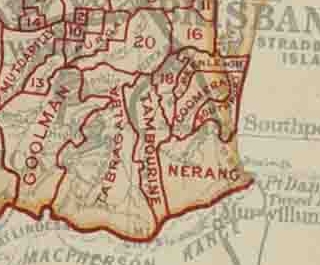1936 to 1948


In 1936 a letter was sent to the Department of Agriculture asking that the whole of Tambourine Mountain be declared a Sanctuary but this request was refused because of the clearing and settlement which had already taken place. But tourism was being encouraged and as such a Toll Gate on the Mountain Road was erected.
As the time period from around the 1940s was very active within Tamborine, and for the fact that significant people of the area can reminisce about this era, for this edition we are going to include a few more items of interest from this time span. Happily, due to the photo of the children on the motorbike being featured in the last edition, a couple of the riders have since made contact with each other and were able to tell a little bit of their time in Tamborine as children.
The Mantova family made some notable changes to Tamborine, with the father, Stanley Joseph Mantova, responsible for building the Tamborine garage (now Tamborine Motor Works), and mother Rose Lillian (nee Dennis) running the service station and shop (now Shell Tamborine) where the family lived. Youngest of eight children, Ray Mantova recalls helping his father build the garage after school using bricks taken from the dismantled Camp Cable site – crushed with coal to create breeze bricks at a rate of four to one. (Construction completed in 1948.)
Ray also tells how he helped rebuild the hall to its existing site with brother’s Cec and Reg after his father made an offer to the Hall Committee in 1941 to pull down the hall and transport it to the new site at a cost of £6 pounds. Ray also states how he planted most of the pine trees in front of the school on the same site. When Camp Cable was in full operation, with an MP Station across the road, Ray remembers how one night hundreds of army trucks rolled into town from Beenleigh, a very exciting time! He also notes how prisoners of the camp were marched up the road into Tamborine and were made to paint the shop in order to keep busy. When the soldiers marched to Canungra, Ray was able to ride his bicycle along the road with a basket full of drinks for which the American soldiers only had notes and so he was able to return with a ‘load of money’. The American soldiers were also very tidy and left the empty bottles in a line on the side of the road ready for retrieval. When the American soldiers left and the Australian soldiers took over the camp, they were less bountiful with sadly only having coins in their pockets. Friend Keith Dean, also recalls how he used to deliver newspapers from his shop to the camp where everything was plentiful and the Americans had racks of lollies, Keith returning home with pocketfuls of sweets.
On one notable occasion in about 1943, Ray rode with his brothers to Camp Cable to see Shirley Temple in concert at the Army Theatre.
Ray’s older sister, May, worked for Keith’s parents at the Post Office, and both Ray and Keith tell how they used to take bacon and eggs from their shops and ride their bicycles with Ray’s brother Reg, and friend John Campbell (son of Jack Campbell, the Shire Clerk) up Tamborine Mountain to cook the food on extremely hot rocks on the side of the road for fun. On their journey they passed through the Toll Gate – always stopped by Controller Harry Flynn – which was positioned near Sandy Creek in order to gather money from travellers as a way of funding the construction of the mountain road, (remnants of the old timbers can apparently still be seen today). The year 1946 saw the erection of the Tamborine Bus Shelter at a cost of £28.2.10, and although the Toll on Tamborine Mountain Road collected £771 pounds in years 1936/1937, it was subsequently abolished.
